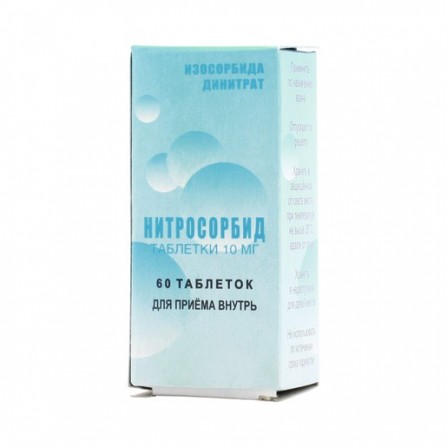Nitrosorbide pills 10 mg 60 pcs
Condition: New product
1000 Items
Rating:
Be the first to write a review!

More info
Active ingredients
Isosorbide dinitrate
Release form
Pills
Composition
1 tablet contains: Active ingredient: isosorbide dinitrate 10 mg.
Pharmacological effect
Peripheral vasodilator with a predominant effect on the venous vessels. Antianginal agent. The mechanism of action is associated with the release of the active substance nitric oxide in the smooth muscles of the blood vessels. Nitric oxide causes the activation of guanylate cyclase and increases the level of cGMP, which ultimately leads to relaxation of smooth muscles. Under the influence of isosorbide dinitrate, arterioles and precapillary sphincters relax to a lesser extent than large arteries and veins. This is partly due to reflex reactions, as well as the less intense formation of nitric oxide from the molecules of the active substance in the walls of arterioles. The action of isosorbide dinitrate is mainly associated with a decrease in myocardial oxygen demand due to a decrease in preload (dilation of peripheral veins and a decrease in blood flow to the right atrium) and afterload (decrease in OPS), as well as direct coronary dilating. It promotes the redistribution of coronary blood flow in the area with reduced blood supply. Increases exercise tolerance in patients with coronary artery disease, angina pectoris. In heart failure, it helps to relieve the myocardium by reducing preload. Reduces pressure in the pulmonary circulation.
Pharmacokinetics
When ingested after absorption from the gastrointestinal tract, isosorbide dinitrate undergoes the effect of a first pass through the liver. Cmax in plasma is reached after 1 hour. When buccal, isosorbide dinitrate is rapidly absorbed, Cmax of the active substance in plasma is reached after 5-6 minutes. Metabolized with the formation of the active metabolite of isosorbide-5-mononitrate, T1 / 2 of which is 5 hours, as well as isosorbide-2-mononitrate with T1 / 2 2.5 hours. T1 / 2 isosorbide dinitrate, depending on the dosage form used, varies from 20 min to 4 h. Excreted by the kidneys and through the intestines.
Indications
For oral administration, sublingually, buccal: relief and prevention of strokes, rehabilitation after myocardial infarction.Chronic heart failure (as part of combination therapy), some forms of pulmonary hypertension, pulmonary heart (as part of combination therapy). For oral injection: arresting and preventing angina attacks as an emergency first aid in acute myocardial infarction and acute left ventricular failure in the prehospital stage . Prevention and treatment of spasm of the coronary arteries using a cardiac catheter. For intravenous administration: acute myocardial infarction, incl. unstable angina, pulmonary edema, complicated by acute left ventricular insufficiency. For cutaneous use: prevention of strokes.
Contraindications
Severe arterial hypotension (systolic blood pressure less than 100 mm Hg, diastolic blood pressure less than 60 mm Hg), collapse, shock, acute myocardial infarction with severe arterial hypotension, hypertrophic obstructive cardiomyopathy, constrictive pericarditis, cardiac swelling, constrictive pericarditis, cardiac swelling, congestive heart attack, congestive heart disease, hypertrophic obstructive cardiomyopathy; , conditions associated with increased intracranial pressure (including hemorrhagic stroke, head injury), angle-closure glaucoma, simultaneous administration of sildenafil (PDE inhibitor), increased sensitivity to nitrate .
Dosage and administration
When ingested a single dose of 10-120 mg, the frequency of administration of 1-5 times / day, depending on the evidence and used dosage form. In sublingual or buccal administration, a single dose is 5–10 mg, the frequency of administration depends on the indications and the patient’s response to treatment. When injected into the oral cavity, use 1-3 doses with an interval of about 30 seconds on the background of breath holding. In acute myocardial infarction and acute heart failure, the initial dose is 1-3 injections. If after 5 minutes there is no improvement, the injection can be repeated under the condition of constant monitoring of blood pressure and heart rate. For the prevention of coronary spasm in the case of catheterization, 1-2 doses should be applied immediately before the procedure. With a / in the introduction of the dosing regimen depends on the clinical situation and the dosage form used. For cutaneous application, the initial dose is 1 g at night, at bedtime, and if necessary in the morning. The duration of treatment is determined in each case individually.




